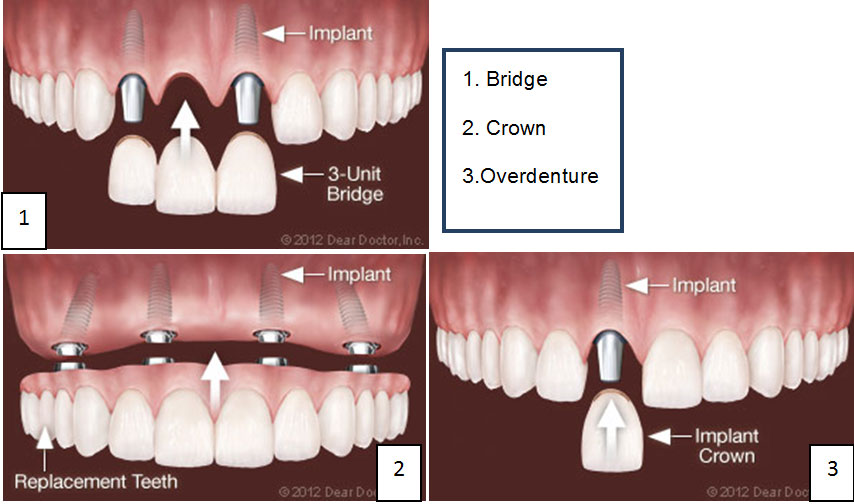What is dental crown?
Dental crown is a fixed prosthesis which covers the whole or part of a tooth or implant. It acts as the most outer layer of a tooth. The crown will be cemented on the tooth temporarily or permanently. The temporary crown or provisional crown is placed while waiting for the permanent prosthesis. The function of the cemented crown on tooth is similar with the function of normal dentition.
The Indications needs of dental crown
The crown is indicated in several clinical situations. Below are several conditions where crown is a choice of treatment.
- Failure of restoration
The crown is needed as a large restoration will have impact to the survival of the teeth. A tooth with big restoration can easily fracture. Crown is indicated to protect the tooth so that the tooth can function well and last longer. The restoration alone is unable to hold the tooth. If high impact or consistent heavy mastication (chewing) force is applied directly, the tooth may fracture or crack.
- Cracked Tooth
Healthy tooth sometime could crack or fracture due to several reasons. The tooth may crack due to patient habits such as chewing ice or nuts. Cracked tooth is likely in cases of repeated filling, trauma, caries and grinding at night (bruxism). The dentition will receive continuous mastication force and as a consequence, the tooth structure becomes weak. It will easily crack and fracture. A dental crown will help to save the tooth from getting worse and to continue in function. Otherwise, the crack will become worse and the tooth needs to be extracted.
- Aesthetic
Teeth alignment, shape and shade are related with appearance of an individual. Most of the patients will seek for a dental treatment if his/her front tooth has a problem. Yellowish, brownish or greyish discolouration, irregular shape and spacing are the common problems. Crown or veneer is a choice of treatment to restore the tooth for aesthetic reason.
- Worn dentition
Worn tooth has sharp, irregular, short and sensitive surface. This happens due to several factors such as the use of hard bristle tooth brush, grinding teeth during sleep (bruxism), regularly consuming acidic/carbonated food or beverage. To overcome this problem, a dental crown can be used. However, a splint is needed to issue to the patient to reduce the abnormal grinding habit and thus protecting the crown of the tooth. Otherwise, the tooth will fracture or causes symptoms.
- Root canal treatment
Root treated tooth is often associated with weakened physical structure. Most of the teeth have large tooth decay (caries) causing severe loss of tooth structure thus become less resistant to continuous chewing forces. Sometime they may also present with colour changes. Crown is used to restore the tooth to optimize oral function. However, not all root canal treated tooth is indicated for crown. For example, front teeth with canal treated, which still has adequate tooth structure and not exposed to heavy chewing or mastication force is not indicated for crowning. Furthermore, root canal teeth opposing the denture, also not indicated for crowning as it receive minimal force as compare to natural dentition.
- Occlusal derangement
When a tooth is extracted and empty space is left for some time, the tooth tends to move towards the space. When this happen, the occlusion of the patient will be deranged or disturbed. This lead to premature contact. In this condition, some of the teeth will receive strong mastication force which leads to temporamandibular joint problem, gum problem, tooth fracture, tooth movement and loss of space for prosthesis. To overcome this problem, the operator will commence mouth rehabilitation. He or she will use ordinary restoration as such composite or amalgam to gain the space for prosthesis. In some condition, they will use dental crown to hold the space so that prosthesis could be constructed.
- Dental caries
Dental caries or tooth decay is caused by bacterial infection. Bacteria such as ‘Streptococcus Mutans’ produces acid that weakened tooth structure and creates cavity on tooth surface. Good oral hygiene practice is necessary to prevent dental caries. When the caries is left unattended, it will spread and tooth structure is lost. If a direct filling is done, caries is removed and then a dental crown is needed to protect the remaining healthy tooth structure.
- Miscellanous
Crown is also retained by dental implant. Implant is screwed in to the bone to replace missing dentition. When osseous- integration is achieved between the bone and implant, prosthesis is made on top of it. Dental crown, bridge and dentures are among the prosthesis used.
References
- Fundamentals of fixed prosthodonic. Shillingburgh et al. Third edition
- http://www.mcardledmd.com/indications-for-crown-use.html
- Reasons for the placement and replacement of crowns in general dental practice.Wilson NA, Whitehead SA, Mjör IA, Wilson NH. Prim Dent Care. 2003 Apr;10(2):53-9
| Last Reviewed | : | 28 August 2020 |
| Writer / Translator | : | Dr. Anis Ezrina bt. Abdul Rahman |
| Accreditor | : | Dr. Saridatun Nur bt. Abdul Salam |
| Reviewer | : | Dr. Roshima bt. Mohd Sharif |













